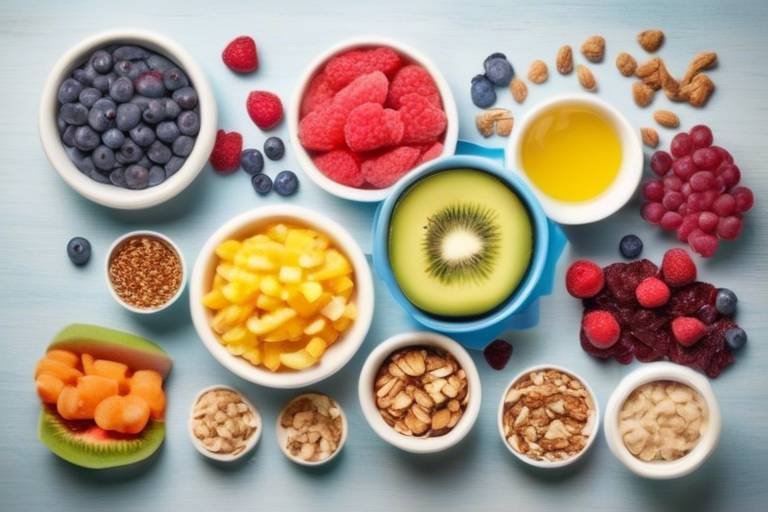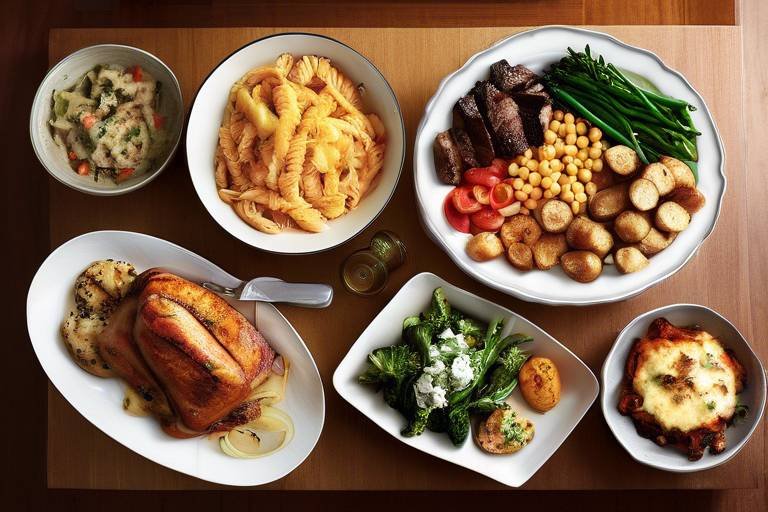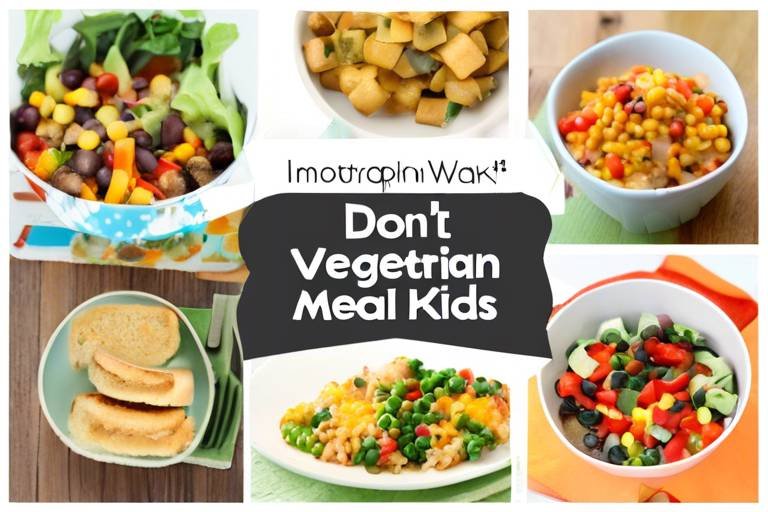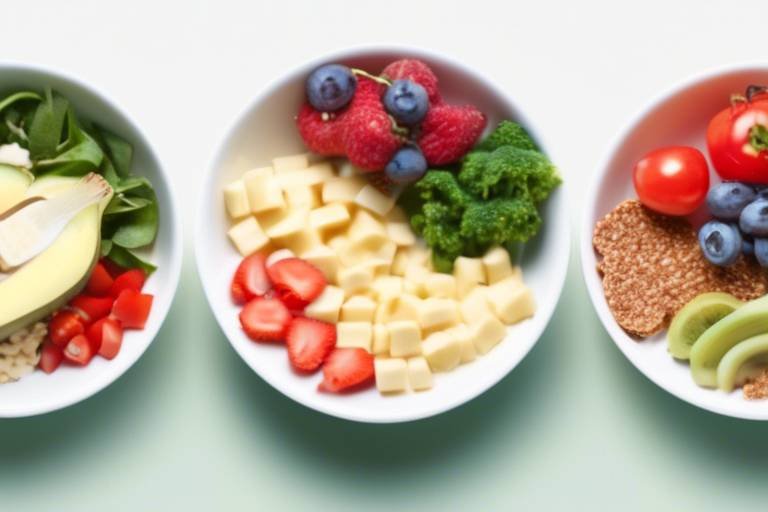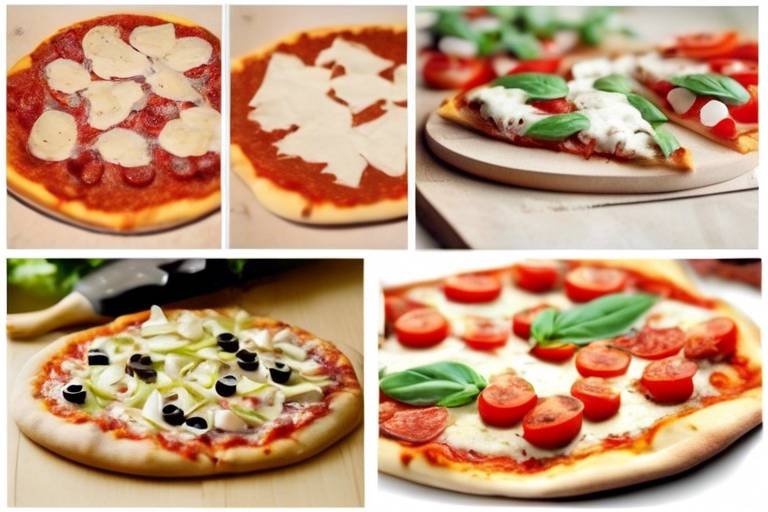Tips for Creating a Healthy and Balanced Meal Plan
Creating a healthy and balanced meal plan is like crafting a masterpiece; it requires attention, creativity, and a dash of knowledge. The journey towards better nutrition doesn't have to be daunting. In fact, with the right approach, it can be both enjoyable and rewarding. Imagine your meal plan as a roadmap guiding you through the world of nutrition, helping you to navigate the complexities of food choices while ensuring you meet your health and wellness goals.
First and foremost, it's essential to recognize that a meal plan isn't just a list of foods; it's a **personalized strategy** tailored to your unique needs. Just as no two individuals are alike, neither are their nutritional requirements. Factors such as age, gender, activity level, and specific health goals play a significant role in shaping what your plate should look like. For instance, an active teenager may require more calories and protein compared to a sedentary adult. Therefore, understanding your nutritional needs is the cornerstone of any effective meal plan.
When it comes to building a balanced plate, think of it as a harmonious blend of flavors and nutrients. A well-constructed meal should ideally include a variety of food groups, ensuring you receive a comprehensive range of vitamins and minerals. The general guideline is to fill half your plate with vegetables and fruits, a quarter with lean proteins, and the remaining quarter with whole grains. This not only satisfies your hunger but also fuels your body with the essential nutrients it craves.
However, knowing what to put on your plate is just the beginning. Portion control is another critical aspect that can make or break your meal plan. It's easy to overindulge, especially when faced with delicious foods. To combat this, consider using measuring tools like cups and scales. These can help you accurately gauge serving sizes, ensuring you enjoy your meals without going overboard. Additionally, practicing mindful eating can transform your dining experience. By paying attention to your hunger cues and savoring each bite, you can foster a healthier relationship with food and avoid mindless snacking.
Variety is the spice of life, and the same goes for your diet. Incorporating a diverse range of foods not only keeps your meals interesting but also maximizes your nutrient intake. Think of your meal plan as a colorful palette; the more colors you include, the more vibrant and nutritious your meals will be. Aim to experiment with different grains, proteins, and vegetables each week. This not only enhances your culinary skills but also introduces you to new flavors and textures.
Lastly, let’s talk about meal prep techniques. Effective meal preparation can save you time and reduce stress, making it easier to stick to your healthy eating goals. Techniques like batch cooking allow you to prepare multiple meals at once, which is a game-changer for busy schedules. By cooking in bulk, you can whip up delicious and nutritious meals that are ready to go whenever hunger strikes. Just remember to store your prepped meals properly to maintain their quality and safety.
In summary, creating a healthy and balanced meal plan is all about understanding your nutritional needs, building balanced plates, controlling portions, incorporating variety, and utilizing effective meal prep techniques. With these tips in mind, you're well on your way to enjoying a nutritious and satisfying diet that supports your health and wellness goals.
- What is the best way to start a meal plan? Begin by assessing your nutritional needs and setting realistic goals based on your lifestyle.
- How can I ensure variety in my meals? Experiment with different recipes and ingredients each week to keep your meals exciting.
- What are some easy meal prep ideas? Try batch cooking grains, proteins, and roasted vegetables that can be mixed and matched throughout the week.
- How do I practice mindful eating? Focus on your food, eliminate distractions, and pay attention to your hunger and fullness cues.

Understanding Nutritional Needs
When it comes to crafting a meal plan that truly works for you, the first step is understanding your unique nutritional needs. Just like a tailor customizes a suit to fit perfectly, your meal plan should be tailored to your individual requirements. Factors such as age, gender, activity level, and health goals play a crucial role in determining what your body needs to thrive.
For instance, a young athlete will have different dietary requirements compared to a sedentary individual or an older adult. This means you need to assess your lifestyle and health conditions carefully. Are you trying to lose weight, build muscle, or simply maintain a healthy lifestyle? Each of these goals will guide your choices in terms of calorie intake and nutrient balance.
To help you get started, consider the following key aspects:
- Age: Nutritional needs change as we age. Children and teenagers require more calories for growth, while older adults may need fewer calories but more nutrients.
- Gender: Men and women typically have different caloric needs and nutrient requirements. For example, women generally need more iron, especially during their reproductive years.
- Activity Level: An active person will require more calories and protein than someone who leads a sedentary lifestyle.
- Health Goals: Whether you want to lose weight, gain muscle, or manage a health condition, your meal plan should reflect these objectives.
One effective approach to understanding your nutritional needs is to consult with a registered dietitian. They can provide personalized recommendations based on your health history and lifestyle. Additionally, there are various online tools and apps that can help you track your food intake and nutritional values, making it easier to stay informed about what you’re consuming.
Moreover, you should familiarize yourself with the concept of macronutrients: carbohydrates, proteins, and fats. Each macronutrient serves a different purpose in the body. For example, carbohydrates are your body's primary energy source, while proteins are essential for muscle repair and growth. Fats, on the other hand, are crucial for hormone production and nutrient absorption. Understanding how these macronutrients fit into your meal plan will empower you to make informed choices.
Finally, it's essential to consider micronutrients—vitamins and minerals that are vital for your body’s overall function. A well-rounded diet rich in fruits, vegetables, whole grains, and lean proteins will help ensure you’re meeting your micronutrient needs. Remember, a colorful plate often means a diverse nutrient profile!
In summary, understanding your nutritional needs is the cornerstone of creating a successful meal plan. By taking into account your age, gender, activity level, and health goals, you can tailor your diet to fuel your body effectively. So, are you ready to take the first step towards a healthier you?

Building a Balanced Plate
Creating a balanced plate is like painting a masterpiece; it requires the right mix of colors, textures, and flavors. When you think about your meals, imagine a plate that is not just visually appealing but also nutritionally sound. A balanced plate typically consists of three main components: carbohydrates, proteins, and fats. Each of these macronutrients plays a vital role in your body, and finding the right proportions can make all the difference in how you feel throughout the day.
Start with carbohydrates, which are your body's primary source of energy. Think of them as the fuel that powers your engine. Whole grains, fruits, and vegetables are excellent choices that not only provide energy but also come packed with vitamins, minerals, and fiber. Aim for about 50% of your plate to be filled with these nutrient-dense foods. For instance, a half-cup of brown rice or a medium-sized sweet potato can serve as your carbohydrate base.
Next up is protein, which is essential for muscle repair and growth. It’s like the building blocks of your body. Lean meats, fish, eggs, beans, and legumes are fantastic sources. Ideally, you want to fill about 25% of your plate with protein. Imagine a grilled chicken breast or a serving of quinoa – both are not only delicious but also provide the necessary protein to keep you feeling satisfied.
Finally, don’t forget about healthy fats, which are crucial for brain health and hormone production. Think of fats as the smooth operator that keeps everything running smoothly. Incorporate sources like avocados, nuts, seeds, and olive oil. These should make up the remaining 25% of your plate. A drizzle of olive oil on your salad or a sprinkle of nuts on your yogurt can elevate your meal both in flavor and nutrition.
To visualize this balance, consider the following table:
| Macronutrient | Examples | Recommended Portion |
|---|---|---|
| Carbohydrates | Whole grains, fruits, vegetables | 50% of your plate |
| Proteins | Lean meats, fish, eggs, beans | 25% of your plate |
| Healthy Fats | Avocados, nuts, olive oil | 25% of your plate |
Remember, building a balanced plate is not just about the food; it’s also about enjoying your meals. Experiment with different combinations of foods and flavors. Maybe try a quinoa salad with mixed greens, cherry tomatoes, and a handful of walnuts, drizzled with a zesty lemon vinaigrette. The key is to find what works for you and keeps your taste buds happy while nourishing your body.
So, the next time you sit down to eat, take a moment to think about your plate. Are you including a variety of foods? Are you balancing your macronutrients? With a little practice, building a balanced plate will become second nature, and you'll be on your way to a healthier, happier you.
- What is a balanced plate? A balanced plate includes a variety of foods that provide carbohydrates, proteins, and healthy fats in appropriate proportions.
- How can I ensure I'm eating enough variety? Try to include different colors and types of foods in your meals, and don’t hesitate to experiment with new recipes.
- Can I adjust these proportions? Yes! Depending on your individual dietary needs and health goals, you may want to adjust the proportions of macronutrients.

Portion Control Strategies
When it comes to maintaining a healthy diet, portion control is your best friend. Think of it as the secret ingredient in the recipe for a balanced lifestyle. By mastering portion sizes, you can enjoy your favorite meals without the guilt or the extra calories. But how do you achieve this? Let’s dive into some effective portion control strategies that can help you navigate your way through your meals.
First off, it's essential to **understand what a portion really is**. Often, we equate a portion with what we see on our plates or in restaurant servings, which can be misleading. A standard portion size is typically much smaller than what we might be served. For instance, a serving of pasta is about one cup, but many restaurants serve two to three times that amount! By being aware of standard serving sizes, you can better gauge how much food you should actually consume.
One effective strategy is to use smaller plates and bowls. This simple trick can make a world of difference. When you eat from a smaller plate, your brain perceives it as a full meal, even if the quantity is less than what you might typically eat. It’s a psychological hack that can help you feel satisfied without overindulging.
Another handy tip is to pre-portion your meals. Instead of eating directly from large containers, take the time to divide your food into smaller, manageable portions. This not only helps you control your intake but also makes it easier to grab a meal on the go. Consider using meal prep containers for this purpose; they can be a game-changer in your kitchen routine!
Additionally, practicing mindful eating can significantly enhance your portion control efforts. This means slowing down and truly savoring each bite. By paying attention to the flavors and textures of your food, you’re more likely to recognize when you’re full. Try putting your fork down between bites, or even engaging in conversation during meals. This can help you tune into your body’s hunger cues more effectively.
Here are some other practical strategies to consider:
- **Measure your food**: Use measuring cups or a kitchen scale to get a better idea of what a serving looks like.
- **Fill half your plate with vegetables**: This not only adds volume to your meal but also ensures you're getting essential nutrients while keeping calories in check.
- **Avoid distractions while eating**: Turn off the TV and put away your phone. When you focus on your meal, you're less likely to overeat.
Lastly, don’t forget to listen to your body. Everyone’s nutritional needs are different, so what works for one person might not work for another. Experiment with different portion sizes and pay attention to how you feel after eating. Over time, you’ll find a balance that suits you best.
In conclusion, mastering portion control is about finding what works for you and making it a part of your daily routine. With these strategies in hand, you can enjoy your meals without the worry of overindulgence, paving the way for a healthier, more balanced lifestyle.
Q: What is the best way to determine my portion sizes?
A: Start by using measuring cups and a kitchen scale to get familiar with standard serving sizes. Over time, you will develop a better intuition for what a healthy portion looks like.
Q: How can I avoid overeating at social gatherings?
A: Before you go, have a small snack to curb your hunger. When you arrive, focus on engaging in conversation rather than just the food. And remember to use smaller plates if possible!
Q: Is it okay to eat snacks between meals?
A: Absolutely! Just be mindful of your portion sizes. Healthy snacks can keep your energy levels up and prevent you from feeling overly hungry at meal times.

Using Measuring Tools
When it comes to creating a healthy and balanced meal plan, can be a game changer. Think of these tools as your trusty sidekicks in the kitchen, helping you ensure that your portion sizes are just right. After all, nobody wants to overindulge and then feel sluggish or guilty afterward, right? Measuring cups, spoons, and food scales can help you accurately gauge the amounts of food you’re consuming, making it easier to stay within your nutritional goals.
Let’s break down the essential measuring tools you might want to keep handy:
- Measuring Cups: Perfect for liquids and dry ingredients, these cups come in various sizes, usually ranging from 1/4 cup to 1 cup. They help you get a clear picture of how much you're eating.
- Measuring Spoons: Great for smaller quantities, measuring spoons can help you accurately add ingredients like oil or spices without going overboard.
- Food Scales: If you’re serious about portion control, a digital kitchen scale can provide precise measurements in grams or ounces. This is especially useful for foods like meat or grains, where serving sizes can vary significantly.
Using these tools isn't just about being precise; it's also about developing a better understanding of what a proper portion looks like. For instance, many people underestimate how much pasta they actually consume. By measuring out a serving size, you’ll start to visualize what a balanced plate looks like. Over time, this practice can help you intuitively gauge portions without needing to measure every single time.
Another aspect of using measuring tools is the consistency they bring to your meal prep. When you measure out ingredients for your favorite recipes, you’ll find that you can replicate those delicious meals consistently. Plus, you’ll be less likely to waste food because you’ll know exactly how much you need. This not only saves money but also contributes to a more sustainable kitchen.
Lastly, it’s important to remember that while measuring tools are incredibly helpful, they shouldn’t become a source of stress. The goal is to enhance your meal planning experience, not to make it feel like a chore. So, embrace these tools as part of your journey towards a healthier lifestyle, and you might just find that they help you enjoy your meals even more!
1. Do I need to measure everything I eat?
No, measuring tools are meant to guide you, not to control your eating. Start by measuring certain foods, especially those that are high in calories, and gradually you’ll develop a sense of portion sizes.
2. How can I estimate portion sizes without measuring tools?
You can use your hand as a guide! For example, a fist-sized portion is roughly equivalent to a cup, while a palm-sized portion is about the size of a serving of protein.
3. Are there any specific measuring tools that are better than others?
Digital kitchen scales are often preferred for their accuracy, especially for solid foods. However, a good set of measuring cups and spoons is essential for liquids and dry ingredients.

Mindful Eating Practices
In our fast-paced world, it's easy to rush through meals without really savoring the experience. Mindful eating is a practice that encourages us to slow down and truly engage with our food. By paying attention to the flavors, textures, and aromas of what we eat, we can enhance our enjoyment and make healthier choices. So, how do we incorporate mindfulness into our eating habits? Let's explore some essential strategies!
First and foremost, it’s important to listen to your body. Before you even sit down to eat, take a moment to assess your hunger levels. Are you genuinely hungry, or are you eating out of boredom or stress? This self-awareness is the first step towards mindful eating. When you sit down for a meal, try to eliminate distractions. That means turning off the TV, putting away your phone, and focusing solely on your food. This allows you to appreciate each bite and recognize when you’re full.
Another key aspect of mindful eating is to chew slowly and savor your food. It might sound simple, but many of us tend to gulp down our meals in a matter of minutes. By taking smaller bites and chewing thoroughly, you not only enhance the taste but also give your body time to signal when it’s full. You might be surprised at how much more satisfying your meal becomes when you take the time to enjoy it!
Additionally, consider the presentation of your meals. A beautifully arranged plate can elevate your dining experience and encourage you to appreciate your food more. Whether it’s a colorful salad or a well-plated entrée, taking a moment to admire your meal can enhance your enjoyment. You can also try to use your senses to fully experience your food. Notice the colors, smell the aromas, and feel the textures. Engaging all your senses can transform eating from a mundane task into a delightful experience.
Lastly, practicing gratitude can significantly enhance your mindful eating journey. Take a moment before you start eating to express gratitude for the food on your plate. Acknowledging where your food comes from and the effort that went into preparing it can foster a deeper connection to your meals. This simple act can shift your mindset and make eating a more meaningful experience.
Incorporating these mindful eating practices into your daily routine can not only improve your relationship with food but also promote better digestion and overall health. So, the next time you sit down for a meal, remember to slow down, savor, and enjoy every bite!
- What is mindful eating? Mindful eating is the practice of being fully present during meals, paying attention to the flavors, textures, and sensations of food.
- How can I practice mindful eating? You can practice mindful eating by eliminating distractions, chewing slowly, appreciating the presentation of your food, and expressing gratitude.
- What are the benefits of mindful eating? Benefits include improved digestion, better portion control, increased satisfaction with meals, and a healthier relationship with food.

Incorporating Variety
When it comes to meal planning, one of the most important aspects is into your diet. Think of your meals as a colorful palette; the more colors you have, the more vibrant and appealing the picture becomes. A diverse diet not only keeps your taste buds excited but also ensures that you’re getting a wide range of nutrients essential for your body’s health. Imagine eating the same meal every day—yawn! Boring, right? But when you mix things up, you can explore new flavors, textures, and even cultures through food.
To truly embrace variety, aim to include different food groups in your meals. This means that your plate should be a delightful mix of fruits, vegetables, whole grains, lean proteins, and healthy fats. Each food group brings its own unique set of vitamins and minerals to the table. For example, leafy greens are packed with iron and calcium, while berries are bursting with antioxidants. By combining these food groups, you not only enhance the nutritional value of your meals but also create a feast for the eyes.
Consider the following tips to incorporate more variety into your meal plan:
- Try New Recipes: Don’t be afraid to step outside your comfort zone! Explore new cuisines and cooking methods. Whether it’s a spicy Thai curry or a hearty Mediterranean dish, experimenting can be fun and rewarding.
- Seasonal Eating: Eating with the seasons means you’ll have access to fresh produce at its peak flavor and nutritional value. Visit local farmers' markets to discover what’s in season and plan your meals around those ingredients.
- Mix and Match: Use the concept of building a bowl: start with a base like quinoa or brown rice, then add a variety of toppings such as roasted vegetables, beans, nuts, and a protein source. This not only adds variety but also makes meal prep easy!
Another effective strategy is to plan themed meal nights. For instance, you could designate Mondays for Mexican cuisine, Wednesdays for Asian-inspired dishes, and Fridays for Italian feasts. This not only breaks the monotony but also gives you something to look forward to each week. Plus, it opens up a world of flavors and ingredients that you might not typically use.
Lastly, don’t forget about the power of herbs and spices. They can transform even the simplest of dishes into extraordinary meals. A sprinkle of fresh basil can elevate a pasta dish, while a dash of cumin can add depth to a stew. So go ahead, get creative in the kitchen!
Incorporating variety isn’t just about making your meals more enjoyable; it’s about nourishing your body and mind. When you embrace a diverse range of foods, you’re setting yourself up for optimal health and wellness. So, let your meals be a celebration of flavors, colors, and nutrients!
Q: Why is it important to have variety in my diet?
A: Variety in your diet helps ensure that you receive a broad spectrum of nutrients necessary for optimal health. Different foods provide different vitamins, minerals, and other beneficial compounds.
Q: How can I easily incorporate variety into my meal planning?
A: You can incorporate variety by trying new recipes, eating seasonally, mixing and matching ingredients, and using different herbs and spices to enhance flavors.
Q: What are some easy ways to experiment with new foods?
A: Start by visiting local farmers' markets, trying out a new recipe each week, or joining a cooking class to learn about different cuisines.

Meal Prep Techniques
When it comes to maintaining a healthy lifestyle, can be your best friend. Imagine having a week’s worth of nutritious meals ready to go, eliminating the stress of daily cooking and the temptation of unhealthy takeout. This is where the magic of meal prepping comes into play! By dedicating a few hours each week to prepare your meals, you can save time, money, and most importantly, ensure that you’re fueling your body with the right nutrients.
One of the most effective methods is batch cooking. This technique involves preparing large quantities of food at once, which you can then portion out for the week. Think of it as cooking in bulk; you can whip up a big pot of quinoa, roast a tray of colorful vegetables, and grill some chicken all in one go. Not only does this save time, but it also allows you to mix and match ingredients throughout the week, keeping your meals exciting and diverse.
To get started with batch cooking, consider these essentials:
- Choose recipes that store well, such as soups, stews, and casseroles.
- Invest in quality storage containers that are microwave-safe and stackable.
- Label your meals with dates to keep track of freshness.
Another crucial aspect of meal prep is storage and reheating. Proper storage techniques are essential to maintain the safety and quality of your food. For instance, make sure to cool cooked meals to room temperature before sealing them in containers to prevent bacterial growth. When it comes to reheating, use methods that preserve flavor and texture, such as steaming or using the oven instead of the microwave when possible. This way, you can enjoy your meals just as much as when they were freshly made.
Additionally, consider creating a meal prep schedule that fits your lifestyle. Some people prefer to prep on Sundays, while others might find mid-week to be more convenient. Whatever works best for you, consistency is key. By setting aside dedicated time for meal prepping, you’re more likely to stick with your healthy eating goals.
Lastly, don’t forget to get creative! Meal prepping doesn’t have to be boring. Experiment with different spices, sauces, and cooking methods to keep your meals flavorful. You might even discover new favorite dishes along the way. Remember, the goal is to make healthy eating as enjoyable and sustainable as possible.
Q: How long can I store meal prepped food?
A: Generally, most cooked meals can be safely stored in the refrigerator for up to four days. If you want to keep them longer, consider freezing your meals, which can extend their shelf life to around three months.
Q: What are some easy meals to start with for meal prep?
A: Some beginner-friendly options include stir-fries, grain bowls, salads, and soups. These meals are versatile and can be tailored to your taste preferences.
Q: Can I meal prep for special diets?
A: Absolutely! Meal prepping can easily accommodate various dietary needs, whether you're vegan, gluten-free, or following a keto diet. Just choose recipes that align with your specific requirements.

Batch Cooking Essentials
Batch cooking is a game changer for anyone looking to streamline their meal preparation and maintain a healthy eating routine. Imagine coming home after a long day and knowing that a delicious, nutritious meal is already waiting for you in the fridge. That’s the beauty of batch cooking! It allows you to prepare multiple meals at once, saving you time and effort throughout the week. But how do you get started? Let's dive into the essentials!
First and foremost, choose the right foods for batch cooking. Not all ingredients are created equal when it comes to storing and reheating. Some foods freeze well, while others may lose their texture and flavor. Here’s a quick breakdown of the best foods to batch cook:
| Food Type | Best for Batch Cooking | Storage Tips |
|---|---|---|
| Grains | Rice, quinoa, and pasta | Store in airtight containers; they last up to a week in the fridge. |
| Proteins | Chicken, beans, and lentils | Cooked proteins can be frozen for up to 3 months. |
| Vegetables | Broccoli, carrots, and bell peppers | Blanch before freezing to maintain color and nutrients. |
| Soups & Stews | Chili, minestrone, and chicken soup | Freeze in portions for easy reheating. |
Once you have your ingredients selected, it’s all about planning. Set aside a few hours on the weekend to cook up a storm. Start by washing and chopping all your vegetables, cooking your grains, and preparing your proteins. Organization is key! Having everything prepped will make the cooking process smoother and more enjoyable. You can even listen to music or a podcast while you work—turning a chore into a fun activity!
After cooking, portion out your meals into containers. This not only helps with portion control but also makes it easier to grab a meal on the go. Invest in some good quality, microwave-safe containers that can be easily stacked in your fridge or freezer. Label each container with the meal name and date to keep track of freshness.
Another essential tip is to consider the flavors and how they hold up over time. Some dishes taste even better after a day in the fridge, as the flavors meld together beautifully. On the other hand, dishes with delicate greens or creamy sauces may not reheat as well. So, think strategically about what you prepare and how you plan to enjoy it throughout the week.
Lastly, always keep in mind that batch cooking is not a one-size-fits-all approach. Everyone's tastes and nutritional needs are different. Experiment with different recipes and find what works best for you. Maybe you’ll discover a new favorite dish along the way!
Q: How long can I store batch-cooked meals?
A: Generally, most cooked meals can be stored in the refrigerator for up to 4 days, while frozen meals can last for about 3 months.
Q: Can I batch cook for special diets?
A: Absolutely! Batch cooking can be adapted to fit any dietary needs, whether you're vegetarian, vegan, gluten-free, or following a specific meal plan.
Q: What are some quick batch cooking recipes?
A: Some quick recipes include chili, stir-fried vegetables with tofu, baked chicken with roasted sweet potatoes, and vegetable soups.
Q: How can I make reheating easier?
A: To make reheating easier, consider portioning meals in single servings and using microwave-safe containers. You can also pre-heat your oven to save time.

Storage and Reheating Tips
When it comes to meal prep, storage and reheating are just as important as the cooking process itself. Properly storing your meals not only helps maintain their freshness but also ensures you’re eating safely. First off, always use airtight containers to keep your meals from spoiling. These containers can be made of glass or BPA-free plastic, and they help to prevent moisture and air from ruining your delicious creations. Remember, the goal is to keep your meals as fresh as possible for when you’re ready to enjoy them!
Next, let’s talk about cooling down your meals before you store them. It’s crucial to let your food cool to room temperature before placing it in the fridge or freezer. This prevents condensation, which can lead to sogginess and spoilage. A good rule of thumb is to let your food sit out for no more than two hours after cooking. If you’re in a hurry, consider dividing larger batches into smaller portions to speed up the cooling process.
For those who love to batch cook, it’s essential to label your containers with the date and contents. This simple step can save you from the dreaded mystery meal scenario. You can use a permanent marker or labels to write down the date you cooked the meal and what it contains. This way, you can keep track of what to eat first and avoid any food waste.
When it comes to reheating, be mindful of the method you choose. Microwaving is quick and convenient, but it can sometimes lead to uneven heating. To ensure your meal is heated evenly, stir it halfway through the reheating process. If you have the time, consider reheating in an oven or on the stovetop for a more evenly cooked meal. For instance, if you’re reheating a casserole, cover it with foil to keep it moist and prevent it from drying out.
Here’s a quick table summarizing the best storage and reheating practices:
| Storage Method | Best For | Reheating Tips |
|---|---|---|
| Airtight Containers | All meal types | Microwave or stovetop; stir halfway |
| Freezer Bags | Soups, stews, and sauces | Defrost in the fridge overnight before reheating |
| Glass Containers | Ovens and microwaves | Cover with foil or a lid for even heating |
Lastly, always check your food before consuming it. If it looks or smells off, it’s better to be safe and throw it away. By following these simple , you can enjoy your prepped meals while ensuring they are safe and tasty!
Q: How long can I store cooked meals in the fridge?
A: Generally, cooked meals can be stored in the fridge for about 3 to 4 days. If you want to keep them longer, consider freezing them.
Q: Can I reheat food more than once?
A: It’s best to reheat food only once to ensure safety and quality. Repeated reheating can lead to foodborne illnesses.
Q: What’s the best way to defrost frozen meals?
A: The safest way to defrost frozen meals is to place them in the refrigerator overnight. Alternatively, you can use the microwave’s defrost setting if you’re short on time.
Frequently Asked Questions
- What are the key components of a healthy meal plan?
A healthy meal plan should include a balance of carbohydrates, proteins, and fats. It's essential to incorporate a variety of fruits, vegetables, whole grains, and lean proteins to ensure you get a wide range of nutrients. Think of your plate as a colorful palette; the more colors you have, the more nutrients you're likely to consume!
- How can I determine my individual nutritional needs?
To assess your nutritional needs, consider factors such as your age, gender, activity level, and specific health goals. You might want to consult a nutritionist or use online calculators that can provide personalized recommendations based on your unique circumstances. It's like tailoring a suit; you want it to fit just right!
- What are some effective portion control strategies?
Portion control can be managed by using smaller plates, measuring out servings, and being mindful of your hunger cues. Try to listen to your body – eat when you're hungry and stop when you're satisfied. It's all about finding that sweet spot where you enjoy your meal without overindulging.
- How do I practice mindful eating?
Mindful eating involves slowing down and savoring each bite. Focus on the flavors, textures, and aromas of your food. Put away distractions like your phone or TV, and take the time to appreciate your meal. It’s like turning a mundane activity into a mini-celebration!
- What are the benefits of batch cooking?
Batch cooking allows you to prepare meals in advance, saving you time during the week and helping you stick to your meal plan. You can cook large portions of healthy foods, portion them into containers, and store them for quick access. Think of it as setting yourself up for success – like having a personal chef at your disposal!
- How should I store prepped meals for freshness?
To maintain freshness, store prepped meals in airtight containers and refrigerate or freeze them as needed. Label your containers with dates to keep track of freshness. Proper storage is key to enjoying your meals later – it's like preserving a fine wine!
- Can I still enjoy my favorite foods while maintaining a healthy meal plan?
Absolutely! The key is moderation and balance. You can incorporate your favorite foods into your meal plan by adjusting portion sizes or finding healthier alternatives. Life is too short to skip the things you love; just make sure they fit within your overall nutritional goals!



